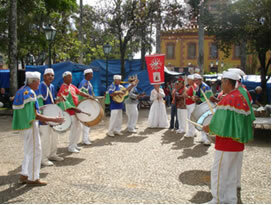The Southeast Region of Brazil comprises the states of Minas Gerais, São Paulo, Rio de Janeiro and Espírito Santo. It presents great cultural diversity, with manifestations of indigenous, African, European and Asian origin.
The cultural manifestations of the Region occur through elements such as:
Congada – The presence of this popular ballet is noted in colonial Brazil and occurs from Ceará to Rio Grande do Sul. In the congada there are two groups of blacks who fight. It's the fight of Good against Evil. Good is represented by Christians, Evil is the group of Moors. Good wears blue clothes, and evil wears red. There are fights, embassies, chants, and Christians always beat the Moors, who are baptized. And all together they celebrate in praise of São Benedito, the patron saint of blacks throughout Brazil. The violas, the canzá (reco-reco), boxes, drums, accompany the singers.

congada
Fandango – in cities along the coast of São Paulo, it is very popular. The fandango is drummed with marked steps, with foot taps, it is danced until midnight. Afterwards, the calmer waltzing fandangos dance.
Batuque – dance of African origin, from the ritual of the procession. It is a very popular party in the interior cities of São Paulo, in the Divino Espírito Santo festivities, or in June festivities. Batuque is danced in a terreiro or public square. A row of men is 15 meters away from the women, when the dance starts, the men approach the women and touch their bellies three times to their partner.
Samba de Lenço – is a dance of African origin, it is samba in urban areas (salon samba), and in rural areas there are three modalities: samba de roda, samba de campineiro and samba de hanchief.
Carnaval – The world's most famous event in Rio attracts Brazilian and foreign tourists to attend the samba school parades. This event has also been highlighted in the state of São Paulo.

Samba Schools Parade at Carnival
Dance of Old People – The dance appears during the festivities of the Divino Espírito Santo. It still exists on the coast of Rio de Janeiro, in Parati and Angra dos Reis. And also in the São Paulo cities of Cunha and São Luís do Paraitinga.
Festa de Iemanjá – Iemanjá is the most prestigious female entity in Candomblé, Umbanda and Macumba. The worship of Yemanjá is held on the night of December 31st to January 1st. On that day the devotees will pay their respects. When night comes, thousands of faithful head to the beach, and everyone celebrates the Queen of the Sea, protector of sea travel and mother of all orixás. People bring gifts, flowers, food and drinks.
Folia de Reis or Reisado – Folia de Reis, a revelry that takes place during the Christmas period, from December 24th to January 6th, is the day dedicated to the Holy Kings. The formation of the folias differs according to the place, but there is always a master, a major leader, responsible for the singing and for the general coordination of the group. His assistant is the foreman, who collects donations and replaces him in case of need. Some revelries bring the figure of the ambassador, who asks permission to enter the houses, pronounces the prophecies and remembers the words written by the prophets about the birth of Christ. There are instrumentalists and singers and some bring the kings, representing the three wise men.
Dance of São Gonçalo – The girls dress in white, pink or blue. Each extra carries a wooden bow decorated with tissue paper in the color of the dress. In certain places, a single man participates in the dance and commands the function, dressed in white, who plays the role of São Gonçalo.
Kayapó – is an indigenous-influenced ballet. Appears in several states of Brazil, with variations: São Paulo, Rio de Janeiro, Minas Gerais.
Ticumbi – is an Espirito Santo version of Congada. It is only found in the state of Espírito Santo, it is a dramatic warrior dance. It is practiced by blacks who dress in white, wear long robes decorated with colorful ribbons.
The cuisine of the Southeast is very diversified and has a strong influence from Indians, slaves and various European and Asian immigrants. Among the typical dishes stand out the capixaba moqueca, made with annatto tincture (ES); cheese bread, tropeiro beans, pork served with cabbage, okra, corn or cassava (MG); feijoada, fried cassava, cod cake, minced meat (RJ); São Paulo facing, São Paulo couscous, farofa, pizza (SP).

Moqueca Capixaba
By Wagner de Cerqueira and Francisco
Graduated in Geography
Source: Brazil School - https://brasilescola.uol.com.br/brasil/aspectos-culturais-regiao-sudeste.htm
